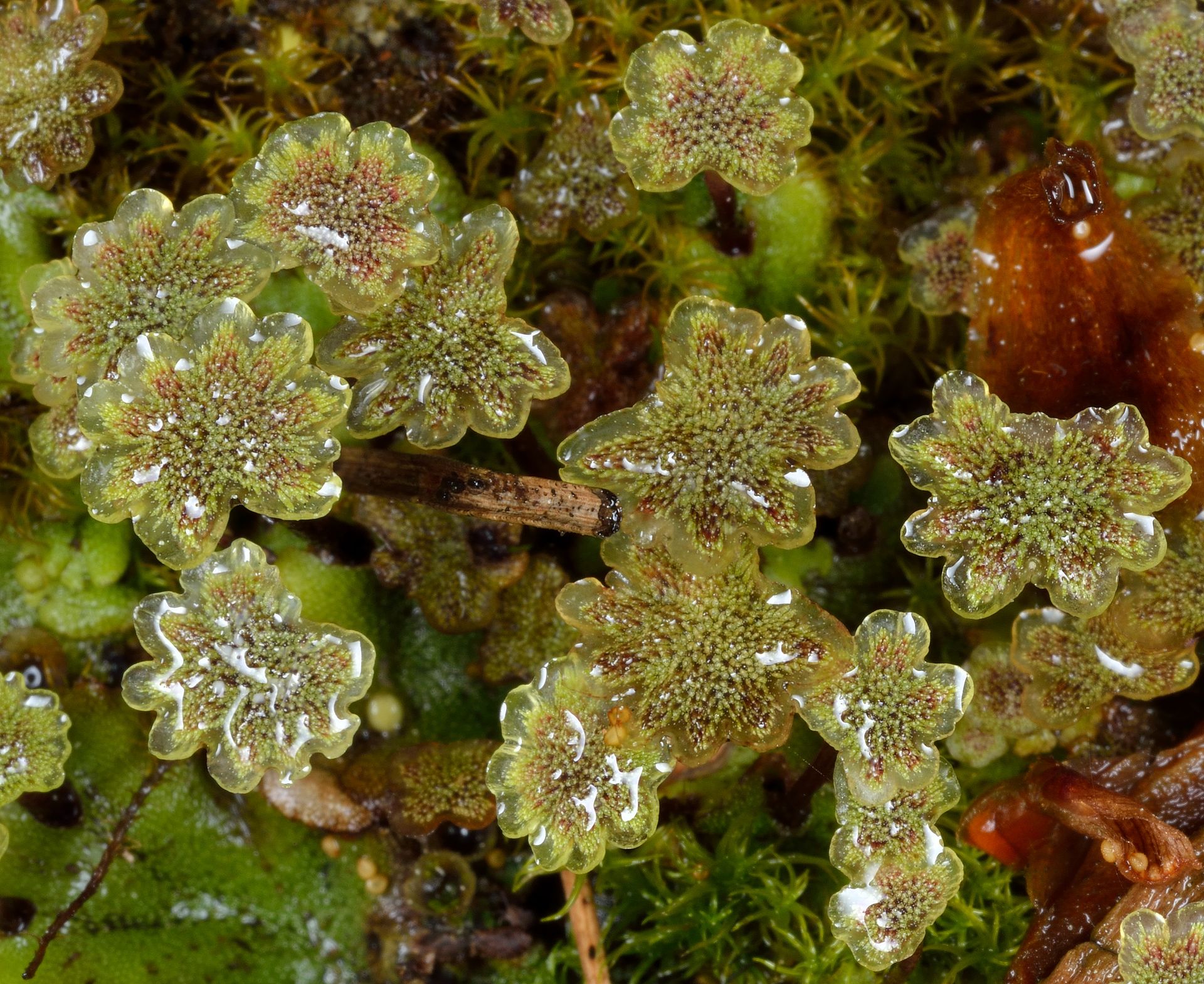2.29: Marchantia - Thalloid Liverwort
- Page ID
- 70379
\( \newcommand{\vecs}[1]{\overset { \scriptstyle \rightharpoonup} {\mathbf{#1}} } \)
\( \newcommand{\vecd}[1]{\overset{-\!-\!\rightharpoonup}{\vphantom{a}\smash {#1}}} \)
\( \newcommand{\dsum}{\displaystyle\sum\limits} \)
\( \newcommand{\dint}{\displaystyle\int\limits} \)
\( \newcommand{\dlim}{\displaystyle\lim\limits} \)
\( \newcommand{\id}{\mathrm{id}}\) \( \newcommand{\Span}{\mathrm{span}}\)
( \newcommand{\kernel}{\mathrm{null}\,}\) \( \newcommand{\range}{\mathrm{range}\,}\)
\( \newcommand{\RealPart}{\mathrm{Re}}\) \( \newcommand{\ImaginaryPart}{\mathrm{Im}}\)
\( \newcommand{\Argument}{\mathrm{Arg}}\) \( \newcommand{\norm}[1]{\| #1 \|}\)
\( \newcommand{\inner}[2]{\langle #1, #2 \rangle}\)
\( \newcommand{\Span}{\mathrm{span}}\)
\( \newcommand{\id}{\mathrm{id}}\)
\( \newcommand{\Span}{\mathrm{span}}\)
\( \newcommand{\kernel}{\mathrm{null}\,}\)
\( \newcommand{\range}{\mathrm{range}\,}\)
\( \newcommand{\RealPart}{\mathrm{Re}}\)
\( \newcommand{\ImaginaryPart}{\mathrm{Im}}\)
\( \newcommand{\Argument}{\mathrm{Arg}}\)
\( \newcommand{\norm}[1]{\| #1 \|}\)
\( \newcommand{\inner}[2]{\langle #1, #2 \rangle}\)
\( \newcommand{\Span}{\mathrm{span}}\) \( \newcommand{\AA}{\unicode[.8,0]{x212B}}\)
\( \newcommand{\vectorA}[1]{\vec{#1}} % arrow\)
\( \newcommand{\vectorAt}[1]{\vec{\text{#1}}} % arrow\)
\( \newcommand{\vectorB}[1]{\overset { \scriptstyle \rightharpoonup} {\mathbf{#1}} } \)
\( \newcommand{\vectorC}[1]{\textbf{#1}} \)
\( \newcommand{\vectorD}[1]{\overrightarrow{#1}} \)
\( \newcommand{\vectorDt}[1]{\overrightarrow{\text{#1}}} \)
\( \newcommand{\vectE}[1]{\overset{-\!-\!\rightharpoonup}{\vphantom{a}\smash{\mathbf {#1}}}} \)
\( \newcommand{\vecs}[1]{\overset { \scriptstyle \rightharpoonup} {\mathbf{#1}} } \)
\( \newcommand{\vecd}[1]{\overset{-\!-\!\rightharpoonup}{\vphantom{a}\smash {#1}}} \)
\(\newcommand{\avec}{\mathbf a}\) \(\newcommand{\bvec}{\mathbf b}\) \(\newcommand{\cvec}{\mathbf c}\) \(\newcommand{\dvec}{\mathbf d}\) \(\newcommand{\dtil}{\widetilde{\mathbf d}}\) \(\newcommand{\evec}{\mathbf e}\) \(\newcommand{\fvec}{\mathbf f}\) \(\newcommand{\nvec}{\mathbf n}\) \(\newcommand{\pvec}{\mathbf p}\) \(\newcommand{\qvec}{\mathbf q}\) \(\newcommand{\svec}{\mathbf s}\) \(\newcommand{\tvec}{\mathbf t}\) \(\newcommand{\uvec}{\mathbf u}\) \(\newcommand{\vvec}{\mathbf v}\) \(\newcommand{\wvec}{\mathbf w}\) \(\newcommand{\xvec}{\mathbf x}\) \(\newcommand{\yvec}{\mathbf y}\) \(\newcommand{\zvec}{\mathbf z}\) \(\newcommand{\rvec}{\mathbf r}\) \(\newcommand{\mvec}{\mathbf m}\) \(\newcommand{\zerovec}{\mathbf 0}\) \(\newcommand{\onevec}{\mathbf 1}\) \(\newcommand{\real}{\mathbb R}\) \(\newcommand{\twovec}[2]{\left[\begin{array}{r}#1 \\ #2 \end{array}\right]}\) \(\newcommand{\ctwovec}[2]{\left[\begin{array}{c}#1 \\ #2 \end{array}\right]}\) \(\newcommand{\threevec}[3]{\left[\begin{array}{r}#1 \\ #2 \\ #3 \end{array}\right]}\) \(\newcommand{\cthreevec}[3]{\left[\begin{array}{c}#1 \\ #2 \\ #3 \end{array}\right]}\) \(\newcommand{\fourvec}[4]{\left[\begin{array}{r}#1 \\ #2 \\ #3 \\ #4 \end{array}\right]}\) \(\newcommand{\cfourvec}[4]{\left[\begin{array}{c}#1 \\ #2 \\ #3 \\ #4 \end{array}\right]}\) \(\newcommand{\fivevec}[5]{\left[\begin{array}{r}#1 \\ #2 \\ #3 \\ #4 \\ #5 \\ \end{array}\right]}\) \(\newcommand{\cfivevec}[5]{\left[\begin{array}{c}#1 \\ #2 \\ #3 \\ #4 \\ #5 \\ \end{array}\right]}\) \(\newcommand{\mattwo}[4]{\left[\begin{array}{rr}#1 \amp #2 \\ #3 \amp #4 \\ \end{array}\right]}\) \(\newcommand{\laspan}[1]{\text{Span}\{#1\}}\) \(\newcommand{\bcal}{\cal B}\) \(\newcommand{\ccal}{\cal C}\) \(\newcommand{\scal}{\cal S}\) \(\newcommand{\wcal}{\cal W}\) \(\newcommand{\ecal}{\cal E}\) \(\newcommand{\coords}[2]{\left\{#1\right\}_{#2}}\) \(\newcommand{\gray}[1]{\color{gray}{#1}}\) \(\newcommand{\lgray}[1]{\color{lightgray}{#1}}\) \(\newcommand{\rank}{\operatorname{rank}}\) \(\newcommand{\row}{\text{Row}}\) \(\newcommand{\col}{\text{Col}}\) \(\renewcommand{\row}{\text{Row}}\) \(\newcommand{\nul}{\text{Nul}}\) \(\newcommand{\var}{\text{Var}}\) \(\newcommand{\corr}{\text{corr}}\) \(\newcommand{\len}[1]{\left|#1\right|}\) \(\newcommand{\bbar}{\overline{\bvec}}\) \(\newcommand{\bhat}{\widehat{\bvec}}\) \(\newcommand{\bperp}{\bvec^\perp}\) \(\newcommand{\xhat}{\widehat{\xvec}}\) \(\newcommand{\vhat}{\widehat{\vvec}}\) \(\newcommand{\uhat}{\widehat{\uvec}}\) \(\newcommand{\what}{\widehat{\wvec}}\) \(\newcommand{\Sighat}{\widehat{\Sigma}}\) \(\newcommand{\lt}{<}\) \(\newcommand{\gt}{>}\) \(\newcommand{\amp}{&}\) \(\definecolor{fillinmathshade}{gray}{0.9}\)Marchantia, a 'complex, thalloid' liverwort
Marchantia is one of the most commonly encountered liverworts. It has a wide distribution (arctic to tropics) and is relatively large and with a distinctive form. It is often encountered in seeps near steep rocky outcrops next to brooks and streams.

Taxonomy and phylogeny
Marchantia is in the Phylum Hepatophyta in the Plant Kingdom. In the past, the three groups of non-vascular plants (mosses, liverworts and hornworts) were grouped together into some taxonomic entity, often a phylum, but recent studies have supported placing the three groups into three separate phyl a , reflecting a view that the liverworts, mosses and hornworts are not obviously connected with each other, other than all being plants.
Structure
(Gametophyte)—Of all the plant groups, the liverworts show the most diversity in form. While some liverworts bear a resemblance to mosses, having a stem axis with appendages ( 'leaves' ), Marchantia is representative of a group of liverworts described as having 'complex thalloid' structure, consisting of a flattened body (a thallus) that generally spreads across the ground surface and is differentiated into a top and bottom. Marchantia is characterized by repeated branching into two parts. The thallus has multiple layers of cells. The top layer has permanently open pores (visible to the naked eye as minute dots) that allow for carbon dioxide entry. Below this skin (dermal) layer lies a layer of chlorophyll containing cells that are loosely arranged with lots of air space to allow for the diffusion of carbon dioxide. Below this is a (usually) thicker layer of cells that lack chlorophyll, and finally the lower skin (epidermis) which has multicellular fish-scale like structures that help attach the liverwort to the substrate, and also rhizoids, cells with thread like extensions that also attach the liverwort to a substrate. The sporophyte is hard to find, being small (less than 1 mm) and imbedded on the underside of archegoniophores (see below).
Sex and reproduction
Like mosses, liverworts show alternation of generations with a 'dominant' gametophyte (dominant = more visible, longer lasting). Under the appropriate conditions the gametophyte of Marchantia (and some other liverworts) grows two types of vertically oriented, umbrella/mushroom shaped structures: antheridiophores and archegoniophores, both roughly 1 cm in height. The antheridiophores produce male structures that produce sperm on the upper surface of the umbrella.

The archegoniophores, which are like umbrellas that lack the webbing between ribs produce female structures, archegonia, on the underside of the ribs.

On the underside of the female structures are produced flask-shaped archegonia, at the base of which is a single egg. When mature, an opening ( 'canal' ) develops from the egg to the tip of the archegonia, providing a route for the sperm to access the egg and allowing for fertilization. After fertilization a small (barely visible to the naked eye) sporophyte is produced, embedded in the tissue that produced the egg. Spores from the sporophyte are dispersed in the air and germinate to produce more gametophytes. Marchantia has separate male and female gametophytes (some liverworts have bisexual gametophytes).
Marchantia also reproduces asexually, producing small cup shaped 'splash cups' with clusters of cells (gemmae) at the base. These can be ejected by rain drops and are capable of producing new gametophytes if the end up in a favorable location.

Matter and energy
Liverwort gametophytes are photosynthetic autotrophs. Minerals are obtained from the absorption of solutes in rainwater. The sporophytes are totally dependent on the gametophyte for nourishment.
Interactions
Marchantia generally appears to require moisture and a lack of competition. It is found on rocks in places where water is seeping through the substrate, or perhaps gently falling from above. Although Marchantia can grow on moist soil it probably is eliminated by organisms (vascular plants) that can grow upwards and outcompete them for light. However, these competitors generally cannot grow without soil, which is probably why Marchantia is usually found on rocks. Although it can grow in full sunlight if moisture is available it often is found in shady conditions. Marchantia benefits, as do most non-vascular plants, from being small and being able to function in conditions where small stature is useful. Marchantia contains a variety of secondary plant compounds that may explain the fact that it apparently is rarely eaten.


